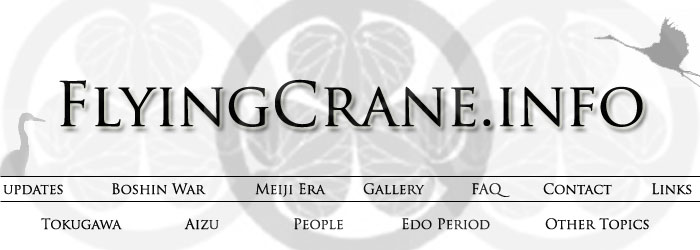

| ::AIZU :: This page is a work in progress. Check back soon!
So why Aizu, one might ask? What is Aizu, where is or was it, and why is it of any particular interest? ::THE AIZU DOMAIN: AN OVERVIEW :: The Aizu domain's history in the Edo period began and ended the same way: with war. It varied in size, it changed hands several times, but its history as an Edo-era domain (han) began and ended with war. In 1600, on the eve of Tokugawa Ieyasu's victory at Sekigahara, Aizu was under the rule of the Uesugi clan. The Uesugi, heirs to a proud tradition of upper samurai and Sengoku-era (16th century) warlords. Their domain was over 1 million koku in size, and contained a wide swath of territory, from Aizu to Echigo and even including Sado Island. The Uesugi, in posession of such a gigantic domain, posed a serious military threat to Tokugawa Ieyasu's plans, and so following a lengthy siege simultaneous to Sekigahara, the Uesugi submitted to Ieyasu, having their income reduced drastically to 300,000 koku, and the center of their holdings transferred to Yonezawa, in nearby Dewa Province. With the Uesugi removed from Aizu, the domain was reduced in size to 600,000 koku and given to Gamo Hidesato. The Gamo rule in Aizu was to last only two generations, with the domain being confiscated due to the lack of an heir. It was then reduced to 400,000 koku, and reassigned to Kato Yoshiaki, under whose family the domain was to last as long as the Gamo, with another confiscation occurring due to internal dissent. After the removal of the Kato family from Aizu, the stage was set for the entry of the clan which was to rule Aizu for the rest of the Edo Period-- the Hoshina family, better known under its latter name the Aizu-Matsudaira. ::THE HOSHINA PRIOR TO AIZU::The Hoshina family, which was to become the lordly house based in Aizu, had a colorful history. It was once a senior vassal house serving the famous Takeda clan of Kai Province. However, in the time of Hoshina Masanao, the Takeda were destroyed, and the Hoshina, with their landholdings at Takato, in Shinano Province, pledged loyalty to Tokugawa Ieyasu, the first Tokugawa shogun. At the time of the Uesugi's defense against the Tokugawa-ordered siege of Aizu in 1600, Masanao was to the west, assisting Tokugawa Hidetada in attacking Ueda Castle. Masanao's son Masamitsu was also involved with Ieyasu's campaigns and various activities, and though he was for a time transferred to a holding in Shimosa Province, he was later returned to Takato. Masamitsu took part in the Osaka Campaign, and was quietly granted Yukimatsumaru (later known as Hoshina Masayuki), the illegitimate son of the aforementioned Tokugawa Hidetada, as his adopted heir. ::HOSHINA MASAYUKI::Hoshina Masayuki, who was to rise from the position of illegitimate son of the shogun, to feudal lord, to head of the Shogunate, was born in Edo (modern-day Tokyo), on June 11, 1611. He was born to the second shogun Tokugawa Hidetada by one of his concubines, Oshizu. Oshizu was the daughter of Kan'o Sakayoshi, a former retainer of the Odawara-Hojo clan (whose heirs were the ruling family of the Sayama domain in Kawachi Province), and had been taken on as the servant to Hidetada's wetnurse. Hidetada, fearing the consequences an illegitimate son might bear at the hands of his jealous, patrician wife Satoko (also known as Oeyo, the niece of Oda Nobunaga), made sure that he was born in utmost secrecy, and quickly placed the young Yukimatsumaru with the nun Shinsho-zen'ni, who was the last daughter of the famed warlord Takeda Shingen. When Yukimatsumaru became three years old, he was transferred to the care of Shingen's 2nd daughter, the nun Kensho-in, who was the widow of Shingen's famed general Anayama Nobukimi. The young boy's existence was only known by a handful of people, among them the roju Doi Toshikatsu, so his life was, to a great extent, in safe hands. Before long, the boy was given in adoption to Hoshina Masamitsu, and became Masamitsu's heir at age 7. (Miyazaki, p. 33) The child, now named Masayuki, had the opportunity to meet his birth father in 1629, at the age of 18. In late 1631, Masayuki succeeded Masamitsu following the latter's death, and became lord of Takato. Following his meeting with Hidetada and subsequently with Hidetada's son and successor Iemitsu, Masayuki was acknowledged as a relative of the shogunal family, and thus began a steady rise to power and success. ::AIZU KARO FAMILIES :: The term "karo" ("house elder") came into use in Aizu in 1684 (Teikyo 1) during the tenure of the 3rd Hoshina/Matsudaira daimyo, Matsudaira Masakata. (Noguchi 86) The seniormost retainer at the time was Saigo Tanomo Chikafusa. Prior to that date, the office was called toshiyori (elder). By 1809, there were nine formal karo families: Kitahara, Naito, Saigo, Tanaka, Ibuka, Miyake, Obara, Yanase, and Kajiwara. Other people could be promoted to karo, but these were the hereditary holders of that rank. Another family, the Yokoyama, was the hereditary Edo-based karo. All of these families went on to fame in the late Bakumatsu and Boshin War years as Aizu's chief military leaders; most were active in Aizu's rehabilitation following the war, in the Meiji era. (Noguchi 82)::REFERENCES :: *Miyazaki Tomihachi. "Aizu-han". pp. 29-40 of Sanbyaku-han Hanshu Jinmei-jiten, Vol. 1. Tokyo: Shin Jinbutsu Oraisha, 1981. *Noguchi Shin'ichi. Aizu-han. Tokyo: Gendai Shokan, 2005.
|